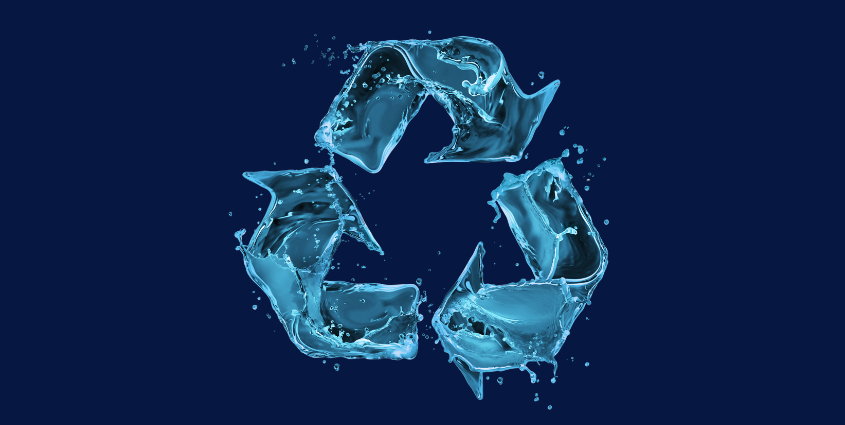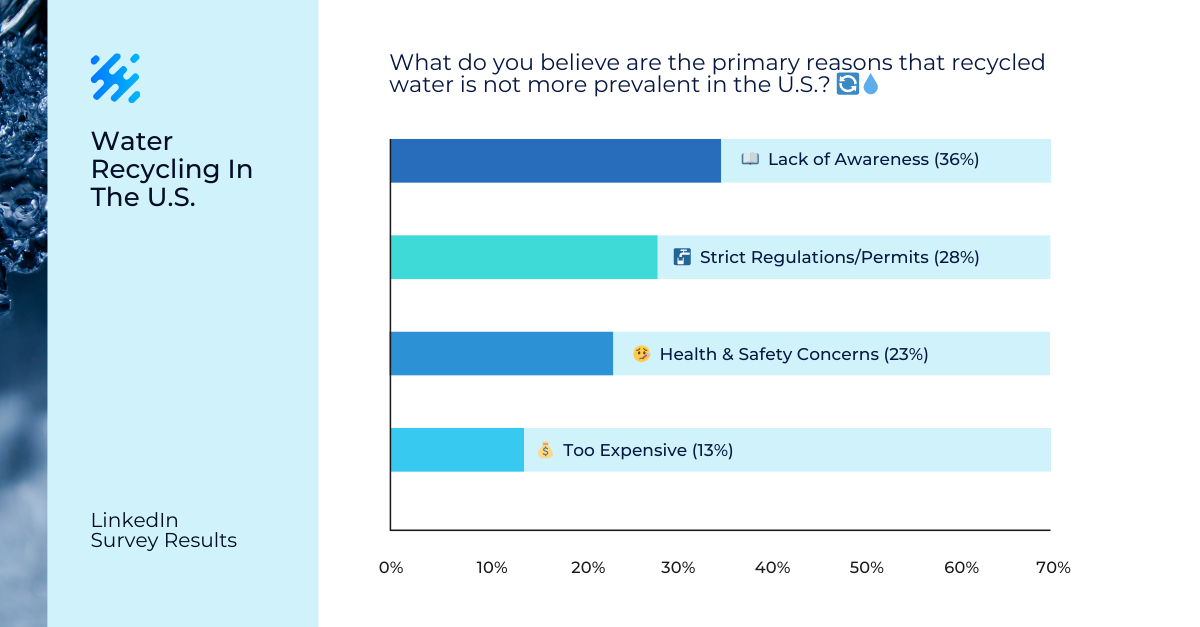Debunking six common onsite water reuse myths


Throughout history, many innovations that are now essential were once viewed with suspicion or even considered taboo, from air conditioning to indoor plumbing. Water recycling is following a similar path.
Water reuse in the built environment is a sustainable practice that presents questions and often a few misconceptions about its use and the quality of water produced. Although technologies for recycling water are safe, proven, and already widely used around the world, the idea can still feel “strange” to some. While recycling water is quickly becoming more prevalent in the U.S. – to the point that direct potable reuse is gaining traction – it’s still not a widely adopted sustainability practice. Yet.
We recently conducted an informal poll to see why people think recycled water is not more prevalent in the United States and the results may surprise you. 28% of respondents believe it’s due to strict regulations and permitting requirements. This was followed closely by 23% thinking that health or safety concerns was the main reason. Only 13% believed the lack of implementation was due to the costs of reuse systems. And most telling was 36% of respondents indicating a lack of awareness of the solution as the main reason that water reuse isn’t more widely adopted.

These perceptions mirror how society has reacted to many now-common technologies in the past. There is often initial skepticism, followed by gradual normalization. At Epic, we want to change these statistics, so we’ve compiled a list of common onsite water reuse misconceptions we hear in the industry and the truth behind them.
Water reuse misconceptions and their reality
Myth 1: Reusing water is only for arid regions
Reality: While water scarcity is a significant concern in drier regions, water reuse technology is beneficial in all types of climates and locations. Even in areas with abundant water resources, water reuse systems can provide financial benefits by reducing water and sewer fees, and sustainability benefits by minimizing the environmental impact of wastewater discharge.
Myth 2: Treated wastewater is not safe for reuse
Reality: Advanced onsite water treatment technologies can effectively treat wastewater to meet and often exceed even the most stringent water quality standards. Onsite water reuse utilizes an advanced treatment process, including membrane filtration, UV treatment, and chlorine disinfection to remove impurities and contaminants, ultimately producing high-quality reclaimed water that’s clean enough to drink. Treated wastewater can be safely reused for non-potable purposes; depending on the jurisdiction, end uses may include landscape irrigation, toilet flushing, HVAC cooling tower makeup, and washing machines.
Just like indoor toilets or air conditioning once faced skepticism, water reuse technology is at a cultural turning point. What may seem unconventional today will become tomorrow’s standard. Recycled water has been safely used for decades. In fact, the practice dates back to 3000 B.C. Our modern centralized municipal facilities have used the technology and process for decades. In fact, the EPA notes that 21 states currently have centralized non-potable water reuse regulations or guidelines, 12 states have onsite non-potable reuse regulations, and 15 states have direct potable reuse regulations or guidelines.
Myth 3: Water reuse is too expensive
Reality: While implementing water reuse systems does involve an upfront investment, they can lead to long-term economic benefits. Epic’s OneWaterTM system and approach aims to provide owners with an ROI of 3-7 years by reducing water supply costs and sewer discharge costs, creating a decentralized local system that is partially decoupled from the municipality. There’s also incentives, grants, and loans available from the state and Federal level that can reduce capital investment costs. Adding in heat recovery solutions can also increase savings and shorten ROI timeline. These systems also mitigate the annual fees associated with conventional wastewater treatment and disposal. Over time, the initial investment in water reuse infrastructure can result in significant cost savings and improved resource efficiency.
Myth 4: Water reuse leads to contamination of building water supply
Reality: Properly designed and managed onsite water reuse systems pose minimal risk to the building’s water supply. By design and regulatory requirement, cross contamination between the domestic and recycled water supply is prohibited. In many jurisdictions, full-building testing is required every few years to ensure no cross contamination has occurred. Regulatory frameworks as well as appropriate safeguards, monitoring, and maintenance practices prevent contamination and protect building water supply. Epic’s operations and maintenance team provides quality care for all onsite reuse operations.
Myth 5: Only large-scale facilities can implement water reuse
Reality: Water reuse systems can be tailored to different scales, from single family homes to individual buildings or entire communities. Advances in decentralized treatment technologies and modular systems like Epic Cleantec’s make it feasible for smaller-scale implementations, providing flexibility and adaptability to various settings and needs. With onsite water reuse, you can capture and treat rainwater, stormwater, greywater or blackwater at the building level, reusing up to 95% of its wastewater.
Myth 6: There’s little knowledge that water reuse technology exists
Reality: While some cities and states have paved the way as early adopters of water conservation strategies, in many places across the country we are seeing adoption of requirements for water reuse technology at the building scale. From New York to Austin and San Francisco, regulators see the water savings and environmental benefits reuse systems can have and are imposing requirements for new construction. It’s also a great marketing tool for owners to encourage prospective residents and tenants to occupy the building; 70% of U.S. consumers prefer to spend their money on companies that are doing right by the planet.
Lack of awareness and public perception may be part of the struggle in wider water reuse adoption; addressing these misconceptions about safety, effectiveness, cost, and use case will be an ongoing mission. We’ll continue to provide accurate information, engage with communities, and highlight successful onsite water reuse projects that can help dispel misconceptions and build trust in this important technology for water sustainability.

